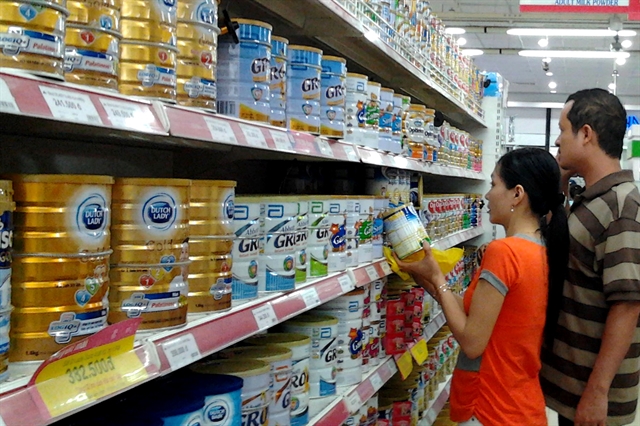 Economy
Economy

Demand for high-value dairy products is also expected to increase sharply due to the young population and growing number of middle-class people in urban areas.

|
| Local milk consumption per capita will reach 28 litres next year. Photo thuonghieucongluan.com.vn |
HÀ NỘI – The Việt Nam Dairy Association forecasts Việt Nam's dairy industry will grow from 9-10 per cent next year and local milk consumption per capita will reach 28 litres in 2020.
Chairman of the Việt Nam Dairy Association Trần Quang Trung said the growth is due to rising incomes and the development of modern sales chains.
Demand for high-value dairy products is also expected to increase sharply due to the young population and growing number of middle-class people in urban areas. These customers often want to experience new products, especially organic products and nut milk products.
However, consumed dairy products are mainly liquid milk, powdered milk, yogurt and condensed milk, while the consumption of other products such as cheese and butter remains modest.
At present, Việt Nam's demand for milk per capita is 26 litres per year, lower than the 35 litres in Thailand, 45 litres in Singapore and between 80-100 litres in Europe. Moreover, the dairy industry has only met about 35 per cent of domestic demand.
Under a development plan of the domestic dairy industry, domestic production of fresh milk is expected to reach 1 billion litres, meeting 38 per cent of the domestic demand in 2020 and increase to 1.4 billion litres, meeting 40 per cent of demand by 2025.
The domestic dairy industry has achieved good growth in recent years, Trung said. Enterprises in the industry have renovated production equipment and facilities and applied technology to production to improve the quality of milk supply and products made from milk.
Two major segments on the local dairy market are liquid milk and powdered milk, accounting for nearly three-quarters of market value with an output of 1.5 million litres of fresh milk and 138,000 tonnes of powdered milk products.
In recent years, dairy businesses have diversified milk products such as organic products and special nutritional products.
Many large enterprises have increased their market shares through developing new products, such as Vietnam Dairy Products Joint Stock Company (Vinamilk), TH Food Chain Joint Stock Company (TH True Milk), Mộc Châu Cow Joint Stock Company (Mộc Châu Milk) and Nestlé Việt Nam, he said.
According to the Department of Livestock Production under the Ministry of Agriculture and Rural Development, the country's cow herd has been growing strongly as large businesses have increased investment in expanding production scale of animal husbandry.
Those businesses have built local raw material areas in the country. They have accelerated development of dairy farms with imports of more cows from the US and Australia.
They have many farms reaching GlobalGAP standards and organic farms to ensure food safety and quality standards. Besides that, they have also built links with the farms with processing plants.
Vinamilk currently has 12 farms across the country, including two farms under European organic standards and 10 farms following GlobalGAP standards.
The company is also building a complex producing organic milk in Laos. It is expected to complete construction at the end of 2020 and its organic fresh milk meeting European and American standards will supply Việt Nam’s market and exports.
Meanwhile, TH Group, parent of TH True Milk, has also spent about US$2.7 billion developing a fresh milk production project on processing milk and some food projects in Russia.
At the end of 2019, Nestlé Vietnam will operate the second phase of expanding the Nestlé Bông Sen Plant in Hưng Yên. This is the sixth factory of Nestlé Group in Việt Nam and the second factory of Nestlé in Hưng Yên. VNS




